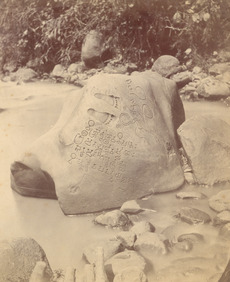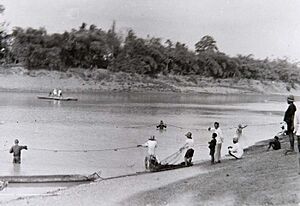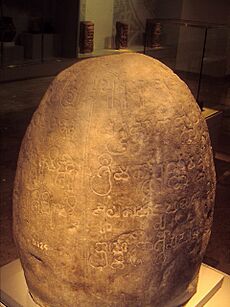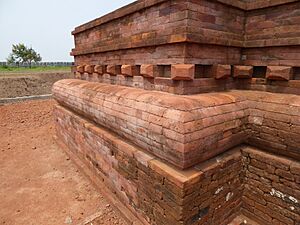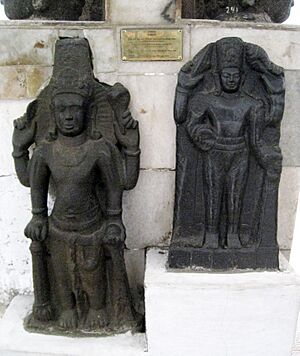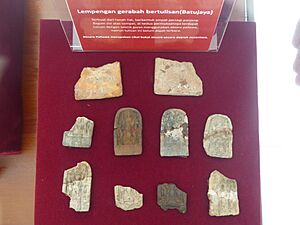Tarumanagara facts for kids
Quick facts for kids
State of Taruma
ᮒᮛᮥᮙᮔᮌᮛ
Tarumanagara |
|||||||||||
|---|---|---|---|---|---|---|---|---|---|---|---|
| ca. 450–669 | |||||||||||
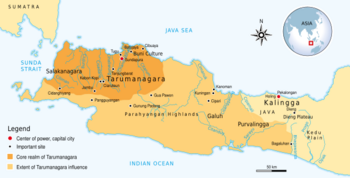
The territory of Tarumanagara
|
|||||||||||
| Capital | Sundapura (between North Jakarta and Bekasi Regency) | ||||||||||
| Common languages | Old Sundanese, Sanskrit | ||||||||||
| Religion | Hinduism, Buddhism, Animism, Sunda Wiwitan | ||||||||||
| Government | Monarchy | ||||||||||
| History | |||||||||||
|
• Established
|
ca. 450 | ||||||||||
|
• Invasion of Sriwijaya
|
669 | ||||||||||
|
|||||||||||
| Today part of | Indonesia | ||||||||||
Tarumanagara (also called Taruma Kingdom or just Taruma) was an old kingdom in western Java. It was one of the first kingdoms in Indonesia to be influenced by Indian culture. Its most famous ruler was King Purnawarman in the 5th century. He created the oldest known stone writings (inscriptions) found in Java, dating back to around 450 CE.
People have found at least seven stone inscriptions linked to this kingdom. They were discovered in West Java, close to Bogor and Jakarta. These include the Ciaruteun inscription, Kebon Kopi I inscription, Jambu, Pasir Awi, and Muara Cianten inscriptions near Bogor. The Tugu inscription was found near Cilincing in North Jakarta. The Cidanghiang inscription was found in Lebak village, south of Banten.
Contents
Where Was Tarumanagara Located?
The stone inscriptions from the Taruma kingdom are the earliest records of Hinduism in the western part of the Malay Archipelago. The coast of West Java, where modern Jakarta is today, was a very important area. It controlled the Sunda Strait, which was a key sea route. This location was great for trade with Sumatra, India, and China.
The kingdom was near modern Jakarta. The Tugu inscription tells us that King Purnawarman built a canal. This canal changed the path of the Cakung River. It also helped drain a coastal area, making it good for farming and building homes. In his inscriptions, Purnawarman said he was connected to the god Vishnu. Priests (Brahmins) performed rituals to bless his water projects. Tarumanagara is thought to have existed from 358 to 669 CE. It was located in the West Java region, around modern-day Bogor, Bekasi, and Jakarta.
The oldest written records of Tarumanagara are found on stone inscriptions. These inscribed stones are called prasasti in Indonesian. Many of these stone inscriptions from the Tarumanagara period have been found in West Java.
How We Know About Tarumanagara
Most of what we know about the Taruma kingdom comes from two main sources. The first is the stone inscriptions found near Bogor and Jakarta. The second is old Chinese historical records from the Sui and Tang dynasties.
In 1863, a large inscribed stone was found in the Ciaruteun river bed near Bogor. This stone is now known as the Ciaruteun inscription. It dates back to the 5th century. It is written in an old Indian script (Vengi letters) and in the Sanskrit language. This is the first inscription that clearly mentions the kingdom's name, "Tarumanagara." It also talks about the kingdom's most famous king.
"The powerful illustrious and brave King, the famous Purnawarman (of the) Tarumanagara (kingdom) whose (print of the) foot soles are the same (as those of) God Vishnu."
Close by, the Kebon Kopi I inscription was found. It is also called the Telapak Gadjah stone. It has an inscription and two large elephant footprints carved into it. The inscription says: "These elephant foot soles, like those of the strong Airavata (the elephant ridden by the god Indra), belong to the Tarumanagara King who is successful and in control."
Chinese historical records also confirm the existence of King Purnawarman and his kingdom. Tarumanagara had strong trade and diplomatic ties with countries between India and China. A Chinese Buddhist monk named Fa Xian wrote about his travels in his book Fo-kuo-chi. He said he stayed on the island of Ye-po-ti (likely the western part of Java) for six months in 412-413 CE. He noted that Buddhism was not well known there. However, Hinduism (practiced by Brahmins) was popular, and local traditional beliefs (animists) also existed.
Between 528 and 669 CE, Tarumanagara sent its representatives to the Chinese court. The old records of the Sui dynasty mention that the king of To-lo-mo (Taruma) sent diplomatic missions to China in 528 and 535. It was noted that this kingdom was far south of China. The records of the Tang dynasty also mention that envoys from To-lo-mo visited the Tang court in 666 and 669.
What Does "Tarumanagara" Mean?
The name Tarumanagara is found in several inscriptions in West Java from around the 4th century. Chinese records also mention To-lo-ma or To-lo-mo, which sounds like "Taruma." Tarumanagara means "the kingdom of Taruma." The name "Taruma" itself is connected to the Citarum River in West Java. In the Sundanese language, ci means "water" or "river." Tarum means "indigo plant." The indigo plant was used to make blue dye.
History of Tarumanagara
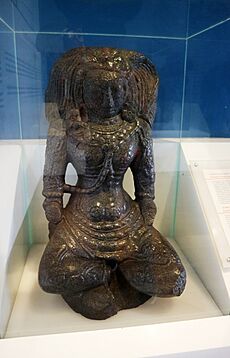
From about 400 BCE to 100 CE, a special type of clay pottery culture grew in northern coastal West Java. This pottery culture is called Buni culture. It was named after Buni village in Bekasi, where it was first found. Experts believe this culture was the start of the Taruma kingdom. The people of the Buni culture were influenced by India. They began to adopt Hindu ideas from India and set up early Hindu communities in Java.
An old Greek geographer named Claudius Ptolemaeus wrote a book in the 2nd century CE. He mentioned a city called Argyre on the western edge of an island called Iabadiou. Iabadiou is likely the Sanskrit word Yawadwipa, which means the island of Java. Argyre means "silver." In Indonesian and Sundanese, silver is perak, which sounds like the Merak port town on Java's western edge.
The Time of King Purnawarman
The history of the Tarumanagara Kingdom mostly comes from several inscriptions from the 5th century AD. These inscriptions are named after where they were found. They include the Ciaruteun, Pasir Koleangkak, Kebonkopi, Tugu, Pasir Awi, Muara Cianten, and Cidanghiang inscriptions. All these inscriptions mention King Purnawarman as the ruler. The Cidanghiang inscription (found in Lebak) says Purnawarman was a great example for rulers everywhere. The Jambu inscription shows the king's large footprints. It has a two-line inscription that says:
"The name of the king who is famous for doing his duties well and who is unmatched is Sri Purnawarman, who rules Taruma. His armor cannot be pierced by enemy arrows. The footprints belong to him who always succeeded in destroying enemy forts. He was always kind and welcomed those loyal to him, but was harsh to his enemies."
Kings After Purnawarman
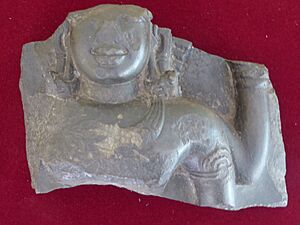
Purnawarman is probably the most famous king of Tarumanagara. This is because many well-documented inscriptions talk about him. Records about the kings who ruled after Purnawarman are not as clear. Most of what we know comes from later writings and local stories.
The names of later Tarumanagara kings are known, but not much else. All their names end with warman (Sanskrit: varman means "shield" or "protector"). This suggests they all belonged to the same royal family.
We know a bit more about King Suryawarman, who ruled from 535 to 561. King Suryawarman built a new capital city further east. He allowed Sundapura and its communities to keep their own ways. Sundapura then became a smaller kingdom called Sunda Sambawa, which was under Tarumanagara's control. Before Suryavarman became king, his son-in-law, Manikmaya, left Sundapura in 526. He went southeast and started a new kingdom called Kendan, near modern Garut city.
Kertawarman ruled from about 561 to 628. During his rule, Manikmaya's grandson, Wretikandayun, started the Galuh Kingdom in 612. It was southeast of Garut, with its capital in Banjar Pataruman. Kertawarman's successor, King Linggawarman, ruled from 628 to 650. He had no sons. Linggawarman's oldest daughter, Manasih, married Tarusbawa, who ruled Sunda Sembawa. Linggawarman's second daughter, Princess Sobakancana, married Dapunta Hyang Sri Jayanasa. He later founded the powerful Srivijaya kingdom.
The Decline of Tarumanagara
According to a 7th-century inscription, Srivijaya (based in Palembang, Sumatra) attacked "Bhumi Jawa." This happened around the same time Tarumanagara began to decline. It is very likely that Srivijaya attacked and defeated the Tarumanagara kingdom around 686 CE. We don't know exactly why Srivijaya attacked. However, it might have been because Jayanasa claimed the throne of Tarumanagara. After all, his wife, Sobakancana, was the daughter of Linggawarman, the last king of Tarumanagara. After this sea invasion, Tarumanagara's power started to fade.
After the Srivijayan invasion, King Tarusbawa moved further inland. He sought safety in the south and built a new capital near the Cipakancilan river (now in modern Bogor). It seems he left the coastal areas, like the ports of Sunda and Kalapa (now in Banten and Jakarta), under Srivijaya's control. This new capital later became the city of Pakuan Pajajaran (or Pajajaran). King Tarusbawa became the first king of the Sunda kings.
Economy and Trade
Chinese records tell us about the goods traded in Taruma. This suggests that the people made a living by hunting, mining, fishing, and trading. They also farmed. The goods traded in Taruma included special hunting products like rhino horn, ivory, and turtle shells. Gold and silver were also traded, which means there was active mining. The Tugu inscription mentions that canals were built for water projects. These irrigation projects suggest that the northern part of West Java and Jakarta became areas with irrigated rice fields. The canals also helped manage water and prevent floods that often hit the capital of Tarumanagara.
Religion in Tarumanagara
According to the 4th-century writings of Faxian, a Buddhist traveler from China, there were three main religions in Taruma kingdom in the early 5th century. These were Buddhism (which Faxian followed), Hinduism, and a religion he called "impure." This "impure" religion likely refers to the local animism beliefs. These were practiced by the people before Hindu-Buddhist ideas arrived.
Hinduism was the main religion in the Tarumanagara kingdom, especially among the ruling class. This is shown by several inscriptions from that time. For example, the Tugu inscription says that Purnawarman's father, called Rajadhiraja Guru, dug a canal in Chandrabhaga. Purnawarman himself is credited with building the Gomati canal. The inscription also says that King Purnawarman gave a thousand cows to Brahmins (Hindu priests). These actions show that Vedic Hinduism was practiced. The Ciaruteun inscription also shows Vedic traditions. It compares Purnawarman's footprints to those of the Hindu god Vishnu. Both the Ciaruteun and Cidanghiang inscriptions mention vikkranta. This refers to Trivikrama, the "three steps" taken by Vishnu's avatar, Vamana. In the Jambu inscription, Purnavarman was compared to the gods Indra and Surya. Vishnu statues found in Cibuaya (from the 7th century) and a Rajarsi statue found in Jakarta also prove that Hinduism was common in Tarumanagara.
Buddhism was also practiced in Tarumanagara, as Faxian reported in the early 5th century. However, he said there were only a few Buddhists in the kingdom. Near the north coast of West Java, archaeologists found earth mounds called unur or hunur by locals. When these mounds were dug up at the Batujaya archaeological site in Karawang (which was part of Tarumanagara), they turned out to be red brick structures. These were either Candi (temples) or stupas (Buddhist shrines).
In total, about 30 sites (13 of which are brick temples) have been found at the Batujaya archaeological complex. These 5th-century findings include temples, stupas, inscriptions, and molded clay tablets. They were discovered in 1995, 1997, and 2001. Some of these tablets show a Buddha sitting on a throne, with other holy figures (bodhisattvas) beside him. They are surrounded by tall stupas and umbrellas. Many Buddhist votive tablets were also found near Blandongan temple, also at Batujaya. This confirms that Buddhism was practiced there.
The layers of the Blandongan temple show different cultures from the 2nd to the 12th century. This means that even after Tarumanagara fell, the Buddhist site of Batujaya was still used. The Batujaya temples were used during the Tarumanagara period (4th to 7th century). They continued to be used much later (7th to 10th century), possibly when Srivijaya had influence over the area.
Tarumanagara's Lasting Impact
Unlike its later kingdom, the Sunda kingdom, which is still remembered in local Sundanese stories, Tarumanagara was completely forgotten by the people of West Java. It wasn't until the late 19th century that historians finally understood the stone inscriptions found near Bogor and Batavia. The discovery and study of many Tarumanagara inscriptions, especially those from King Purnawarman, showed that this kingdom was the first Hindu state in western Indonesia. Along with Kutai and Kalingga, Tarumanagara is remembered as one of the first states that began Indonesia's recorded history.
Tarumanagara is especially important for the city of Bekasi and its surrounding area. Local historians believe that the capital of Tarumanagara was located in or near modern Bekasi city. The name Chandrabhaga, mentioned in a Tarumanagara inscription, is thought to be the old name for Bekasi. Chandrabhaga (Sanskrit for "moon river") changed to Bhagasasi and then became Bekasi.
The Tarumanagara kingdom also gave its name to Tarumanagara University. This is a private university in Jakarta, founded in 1959.
See also
- History of Indonesia
- List of monarchs of Java
|


